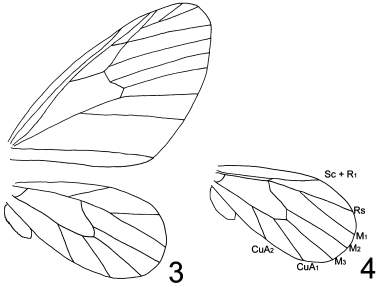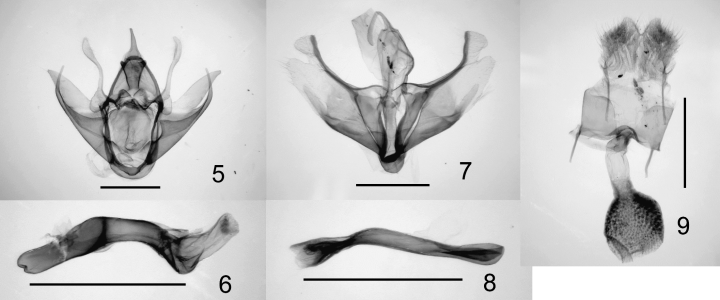Taxonomic review of the genus Trichopterigia Hampson (Lepidoptera: Geometridae) in Korea
Abstract
Korean species of the larentiine genus Trichopterigia Hampson are reviewed. Two species, T. consobrinaria (Leech) and T. costipunctaria Leech, are reported for the first time from the Korean peninsula. Diagnoses of the genus and species are provided, with brief descriptions of adults, including male and female genitalia.
Introduction
The genus Trichopterigia Hampson is a medium-sized geometrid moth group distributed in the Oriental subtropics and eastern Palearctic region. Currently, 35 species have been recorded worldwide, and high species diversity is found in northern India and Nepal, where 21 species occur (Scoble 1999). Hampson (1895) described the genus Trichopterigia with Lobophora decorata Moore as the type species based on morphological characters of the head, leg and wing venation. He distinguished this genus from the closely related genus Trichopteryx Hübner by the formation and number of areoles in the forewing. Prout (1914) described the diagnostic characters of the genus as being a single areole, long labial palpi, a small lobe of hindwing and lack of a submedian vein (A) of the hindwing.
Larvae of the Japanese species of Trichopterigia are bright green and robust, rather flattened, with lateral ridges (Sug 1987). Species of the genus feed on the young foliage of deciduous trees, particularly Quercus (Fagaceae) and Coriaria (Coriariaceae) (Sugi 1987; Teramoto 1993; Holloway 1997). However, a systematic analysis of the tribe Trichopterigini has not yet been carried out and the monophyly of each group of the tribe, including Trichopterigia , is not well established.
Until now, no Trichopterigia species have been known from Korea. The purpose of the present study is to report the occurrence of two species of Trichopterigia in Korea. As stated earlier, the monophyletic nature of the genus and the generic relationships of the Trichopterigini are uncertain. In the present study, we describe the species following the classification of Trichopterigia by Scoble (1999). Given that the general characters of the genus are similar to those of other Trichopterigini genera, a systematic study of the tribe is unquestionably necessary.
Materials and methods
Moths were examined externally and were dissected for genitalia examination, following the general procedure of Bolte (1990). Nomenclature for adult morphology and genitalia follows Hausmann (2001). The material examined is now preserved at Mokpo National University, Jeonnam, Korea (MNU). Abbreviations are: TL, type locality; GW, Gangwon-do; GG, Gyunggi-do; JN, Jeollanam-do.
Taxonomy
Trichopterigia Hampson, 1895: 332
Type species: Lobophora decorata Moore, 1888. TL: Darjeeling, India.
Diagnosis. Moths of Trichopterigia have white or yellowish wings with numerous fine wavy fascia on the forewing. The hindwings of males are distinguished by the presence of an anal area and a dorsally folded small lobe. The male genitalia are distinguished by the divided valva and long, often strongly sclerotized, basal and saccular process. In female genitalia, the ductus bursae is of variable length, breadth and sclerotization, and the spherical or elongate corpus bursae is invested from fine to coarse spinular signa (Holloway, 1997). The monophyly of the genus is not yet clearly established.
Trichopterigia consobrinaria (Leech) (Korean name: ssang-geom-un-ddi-jan-nal-gae-mul-gyeol-ja-na-bang)

Adults of Korean Trichopterigia . 1Trichopterigia consobrinaria ; 2Trichopterigia costipunctaria .

Wing venation of Trichopterigia . 3 Forewing and hindwing of Trichopterigia consobrinaria ; 4 Hindwing of Trichopterigia costipunctaria .

Male and female genitalia of Trichopterigia . 5–8 Male genitalia; 9 female genitalia. 5,6 Trichopterigia consobrinaria ; 7–9Trichopterigia costipunctaria . Scale bars, 1 mm.
Lobophora consobrinaria Leech, 1891: 54. TL: Gifu, Japan.
Diagnosis. This species is distinguished by its whitish wings with relatively thick dark brownish ante- and post-medial lines on the forewing. Although this species is similar to other species in closely related genera in the Trichopterigini with respect to wing pattern elements, the centrally white central fascia of the forewing is a diagnostic character. The male genitalia are distinguished by the developed subscaphium, a pair of hump-shaped transtilla and the divided valva with long basal process and apically strongly upturned saccular process. The female genitalia of Trichopterigia consobrinaria (based on Xue & Zhu 1999, fig. 149) are similar to those of Trichopterigia costipunctaria , but the former can be distinguished from the latter by the presence of relatively thick ductus bursae with spines and elliptical corpus bursae with membranous appendix bursae.
Description (Fig. 1). Wingspan 22–24 mm. Antennae filiform; frons covered with white and brown scales; labial palpi upturned, approximately 1.5 times eye diameter, with minute third segment. Body yellowish white; hindleg with one pair of tibial spurs, hind tibia with yellowish white long sexual tufts. Wings yellowish white; forewing basal line outwardly slanted; antemedial line rather thick, brownish; postmedial line thick, dentate, brownish; central fascia distinct with white band between brownish ante- and post-medial lines; single areole formed by R and M1 veins; subtermen and termen distinct with brown horizontal bar-like lines on veins. Hindwing whitish, anal margin reduced.
Male genitalia (Figs 5,6). Uncus tapering; subscaphium strongly sclerotized; tegumen shorter than the total length of vinculum and saccus; transtilla a pair of hump-shaped processes; fultura inferior and broad without modification; saccus broad, semi-rounded. Valva divided into three processes; basal arm long and digitate; medial arm a slender process, tapering to the distal tip; saccular arm strongly sclerotized, upturned and sharply pointed. Aedeagus medially bent without a cornutus.
Female genitalia (based on Xue & Zhu 1999). Sterigmata simple; antrum broad, sclerotized without process; ductus bursae broad, anteriorly spinular process; corpus bursae elliptical, inner wall filled with spinular signa; appendix bursae ovate, membranous.
Materials examined. JN: 4♂, Mount Duryun, JN, Haenam, 28.iii.2003, S.W. Choi and T.H. Hyun, leg. coll. MNU.
Food plant. Quercus aliena (Fagaceae) (Sugi 1987; Teramoto 1993).
Distribution. Korea, Japan, Taiwan.
Trichopterigia costipunctaria Leech (Korean name: nerb-un-geom-jeong-ddi-jan-nal-gae-mul-gyeol-ja-na-bang)
Lobophora costipunctaria Leech, 1897: 73. TL: Gifu, Japan.
Diagnosis. This species is similar to Acasis viretata (Hübner) with respect to the shape of the wing pattern elements, but can be distinguished by the larger wingspan and by the male and female genitalia. The thick central fascia of the forewing without a central whitish band is a distinguishing character of this species in comparison with T. consobrinaria . The male genitalia of T. costipunctaria are distinguished from those of T. consobrinaria by the slender and long uncus and short basal and saccular process of relatively thick valva. The female genitalia are distinguished by the relatively large papillae anales with dense hairs, simple antrum, thin ductus bursae and ovate corpus bursae with complete filling of minute signa.
Description (Fig. 2). Wingspan 22–24 mm. Antennae filiform; frons covered with brown and yellowish white scales; labial palpi upturned, approximately 1.5 times eye diameter. Body brownish, hindleg with one pair of tibial spurs, hind tibia with yellowish white long sexual tufts. Wings ochreous; forewing basal line thick and brownish; central fascia distinct with a dark brownish thick band; single areole formed by R and M1 veins; dark brownish horizontal lines on veins between postmedial line and subtermen; subtermen with a brown band-shaped transverse line. Hindwing whitish, with dark postmedial and subterminal lines; Sc + R1 and Rs anastomosing and meet just before the R–M cross vein (Fig. 4).
Male genitalia (Figs 7,8). Uncus long and slender; subscaphium weakly developed; tegumen shorter than the total length of vinculum and saccus; fultura inferior and broad without modification; saccus semi-rounded. Valva slender; costa thin and sclerotized, distal tip separated and expanded; saccular arm slender and sclerotized. Aedeagus slender, distally slightly bent without a cornutus.
Female genitalia (Fig. 9). Papillae anales broad with dense hairs; sterigmata simple; antrum broad, sclerotized without lateral process; ductus bursae thin, without sclerotized process; corpus bursae ovate, inner wall covered with minute spinular signa; appendix bursae absent.
Materials examined. GW: 1, Manji, Jeongseon-gun, 4.iv.2001, S. S. Kim, leg.; GG: Mount Soyosan, 1, 3.iv.1993, 21♀, 17.iv.1993, S.S. Kim; 1 Gwangneung, 27.iii.1982, K.-J. Won, leg.
Food plants. Quercus aliena , Quercus glauca , Quercus myrsinaefolia (Fagaceae) (Teramoto 1993).
Distribution. Korea, Japan.
Acknowledgments
We would like to thank Mr Kap-Jae Won (Korea National Arboretum, Gwangneung, Korea) for providing a specimen, Mr Tae-Hyun Hyun (Mokpo National University, Jeonnam, Korea) for his help with fieldwork and Ms Marana Park (Mokpo National University, Jeonnam, Korea) for drawing the wing venation. This study was supported by a grant from the Korea Research Foundation (R-05-2004-000-10285-0).




